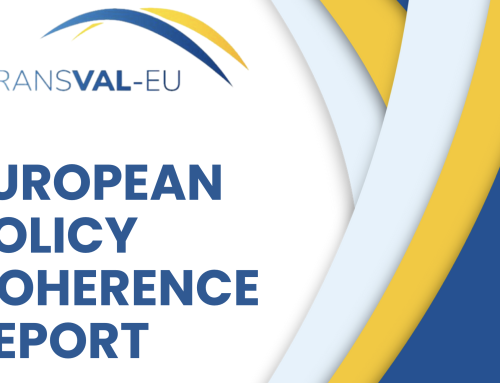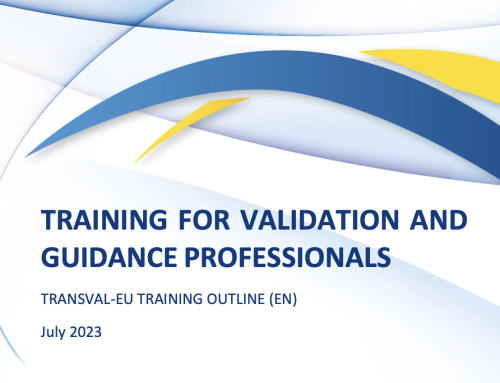Learning outcomes: Validation and the EQF/NQF
A paradigm shift toward learning outcomes as common language: Instead of focusing on learning inputs, e.g. the length of learning initiatives or the form and setting of learning as well as the content, learning outcomes help to reduce barriers and build bridges (Cedefop 2009: 7), defining “what a learner knows, understands and is able to do on completion of a learning process, which are defined in terms of knowledge, skills and competence”. (EQF 2008: 4). The development of the European Qualifications Framework dates back to 2004 as an answer to the quest of a common reference point and transparency tool for qualifications (ET 2008: 4). In 2008, the EQF recommendation was a concerted start and common denominator for the member states to develop National Qualification Frameworks, allocating national qualifications based on learning outcomes from different educational and professional backgrounds to the National Qualification Framework and referencing it to the European Qualification Framework. The goal was to provide greater clarity and better comparability as well as supporting mobility.
The focus on learning outcomes is what links the National/European Qualification Frameworks and validation, the “glue binding together a wide range of tools and initiatives emerging from these policy initiatives and cooperation processes” (Cedefop 2016: 21) with the aim to improve transparency, comparability, transversability and recognition of competences and/or qualifications (idem: 23).
The taxonomy of educational objectives by Benjamin Bloom and collaborators in 1956 is “one of the most important theoretical influences on thinking about learning outcomes and progression” (Cedefop 2016: 35). The hierarchical classification consists of six major categories: knowledge, comprehension, application, analysis, synthesis and evaluation. A revision with the title “A taxonomy for teaching, learning and assessment” in 2001 introduces a more dynamic conception of classifications, “using verbs and gerunds to label their categories and subcategories rather than the nouns of the original taxonomy” (see www.bloomstaxonomy.net). In an UNESCO study on level-setting, recognition of learning outcomes and the use of level descriptors as an international inventory of frameworks, it is argued that the behaviourist approach that Bloom’s taxonomy is rooted in has dominated the discourse, especially concerning qualifications frameworks (Keevy/Chakroun 2015 : 35). Alternative taxonomies rooted in constructivist theories have emerged, describing the progression from “novice to expert” (the Dreyfus taxonomy, 1986) and the notion of understanding as increasing in number and complexity of connections (the SOLO taxonomy, an acronym for Structure of Observed Learning outcomes, 1982) (Cedefop 2016: 37; Keevy/Chakroun 2015: 49).
In the description of progression of learning outcomes, challenges arise in describing vertical and horizontal dimensions and the attempt in “setting standards for excellence for all learners alongside supporting individual differences and interests” (Cedefop 2016: 42). On policy level, the transparency of qualification is the focal point of attention whereas at pedagogy level, “learning outcomes support learner-centred approaches, including formative assessment of learner understanding and individualization to meet learner needs better”, providing an important shift to a learner-centered view. “In complex systems, collaboration and opportunities for mutual learning are important at both policy and practitioner levels. Peer learning among countries is also an important aspect of learning outcomes approaches. This kind of cooperation provides a forum for sharing insights on the principles of effective practices, and opportunities to develop a shared language.” (Cedefop 2016: 53). Accountability and quality assurance are vital to ensure “the credibility of assessment tools measuring the achievement of learning outcomes among individuals and institutions” (Cedefop 2016: 168) and also raising trust which is, as stated in the peer review methodology, the currency in validation processes.
Notes:
RECOMMENDATION OF THE EUROPEAN PARLIAMENT AND OF THE COUNCIL of 23 April 2008 on the establishment of the European Qualifications Framework for lifelong learning.
Education and Training (2008) : The European Qualifications Framework for Lifelong Learning (EQF). Luxembourg: Office for Official Publications of the European Communities. DOI 10.2766/14352
EQF_broch_2008_en.pdf (ecompetences.eu)
Cedefop (2009): The shift to learning outcomes. Policies and Practices in Europe. Cedefop Reference series; 72 Luxembourg: Office for Official Publications of the European Communities, 2009
Cedefop (2016): Application of learning outcomes approaches across Europe. A comparative study. Cedefop reference series; no 105. Luxembourg: Publications Office of the European Union.
Keevy, J. and Chakroun, B. 2015. Level-setting and recognition of learning outcomes. The use of level descriptors in the twenty-first century. Paris: UNESCO.




